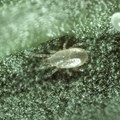
Find out more about our thrip controls
Amblyseius cucumeris - Predatory mite that feeds on most species of young thrips larvae, and in the absence of thrips, on pollen.
Orius laevigatus - Commonly known as the insidious flower bug, is a species of minute pirate bug. It has a long history of providing effective and reliable thrips control in a range of protected crops, often killing far more thrips than they need to reach maturity.
Adults will attack all stages of thrips on plants, whilst nymphs prefer the larvae. Orius bugs will also feed on aphids, mites, whiteflies and moth eggs.
Orius laevigatus performs well on the majority of crops, particularly those with pollen producing flowers.
Amblyseius montdorensis - Predatory mite that controls whitefly (eggs and larvae), as well as thrips. It will not control established populations or where large numbers of adults are moving into the crop.
Consumes more thrips per day than the standard A. cucumeris and unlike A. cucumeris will predate on second instar thrips. Populations have the potential to grow faster than A. cucumeris.
Steinernema feltiae - Contains the insect pathogenic nematode as infective juveniles. The nematodes swim freely through moist compost (but can drown if waterlogged). They are attracted to insect larvae and enter the body where a pellet of bacteria is released that kills the pest organism.
Most species of scale insects are controlled where nematodes can be directly targeted. Spray onto foliage when above 14° and less than 27°, for best results maintain a wet leaf for several hours after application, activity ceases when leaves dry.







